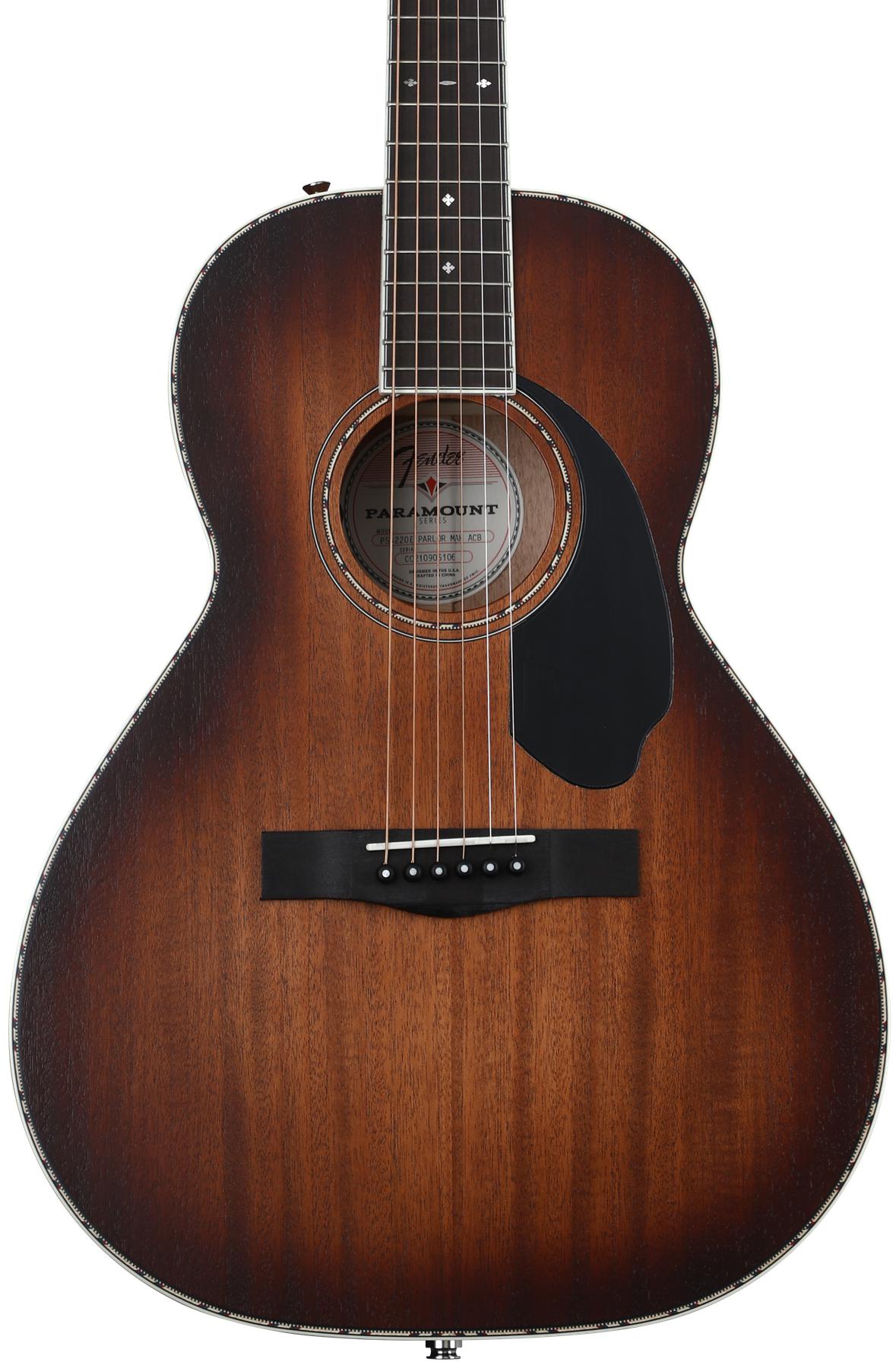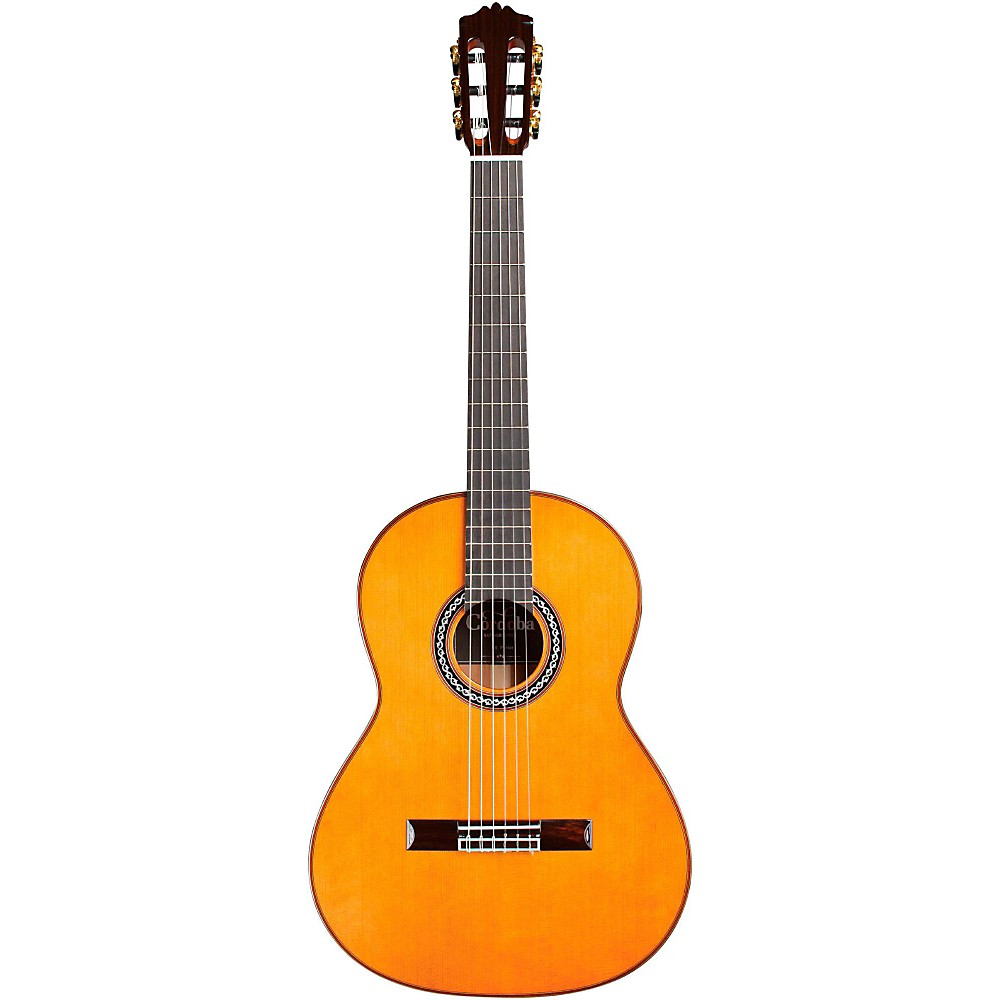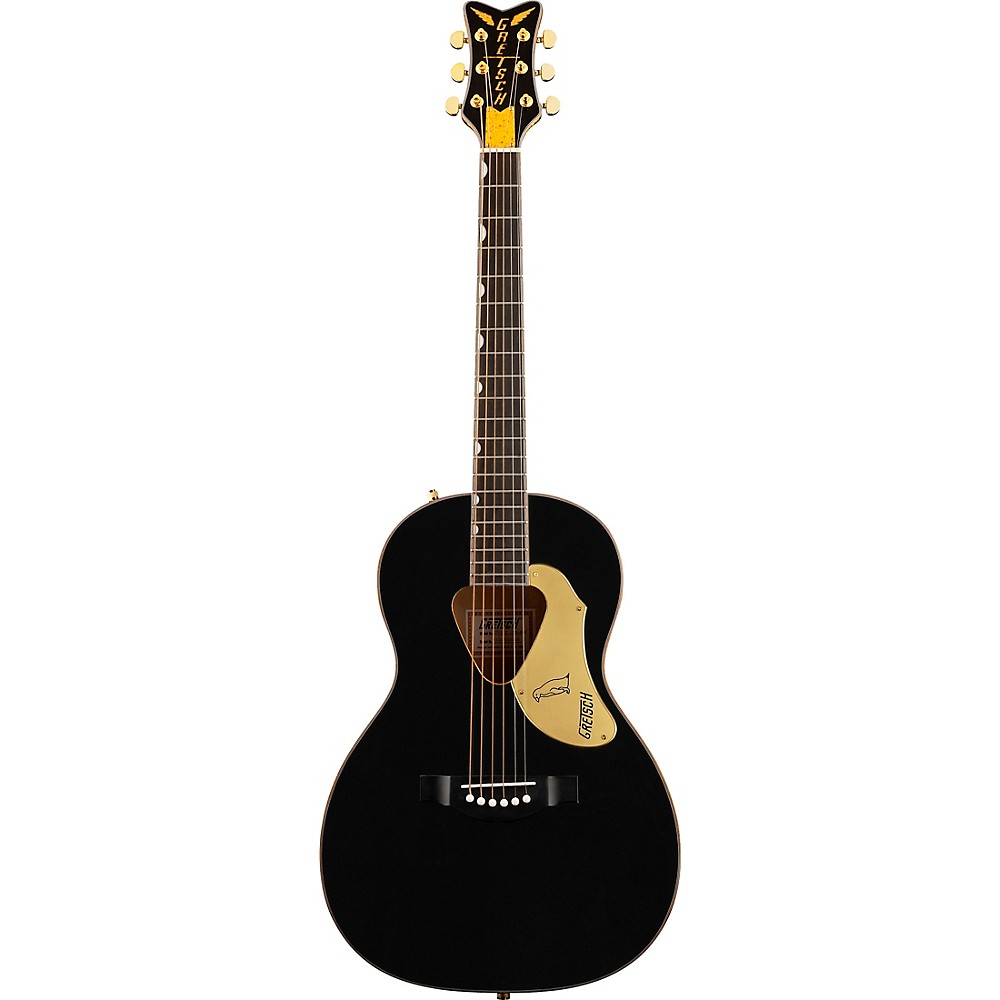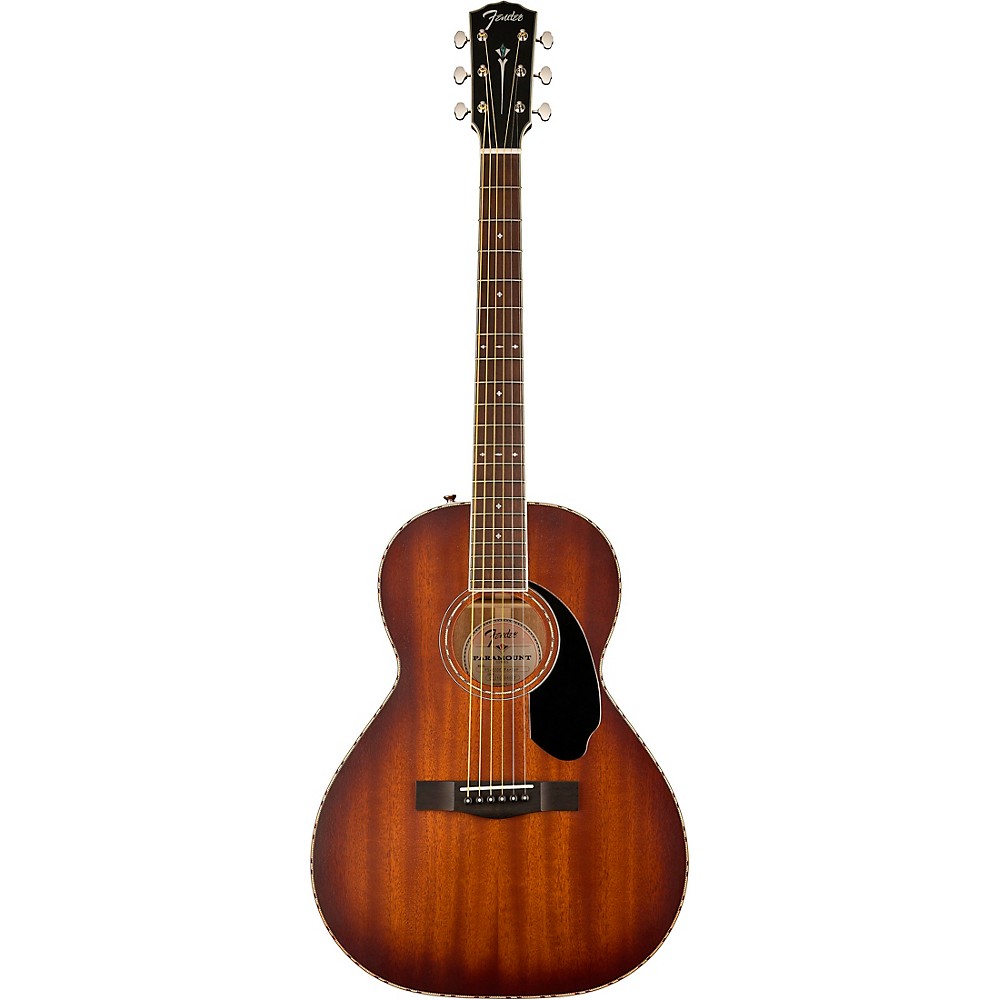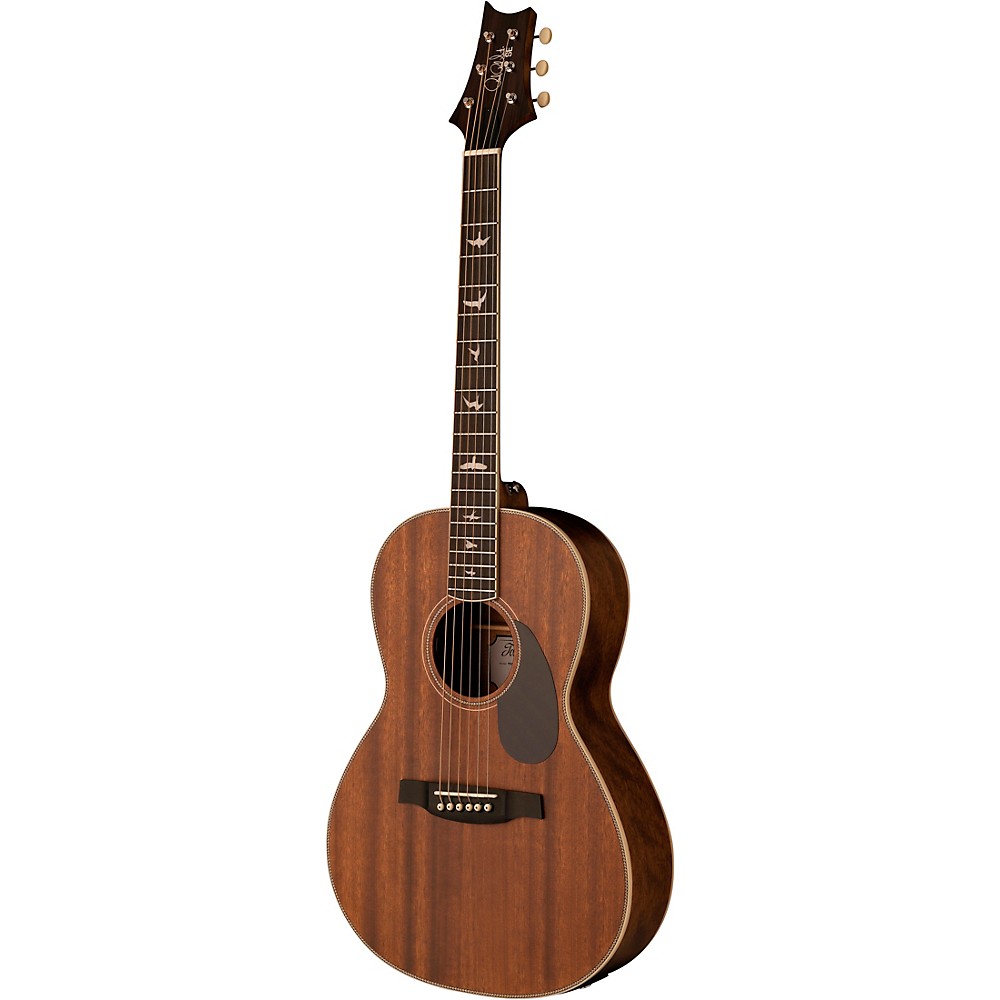Last Updated on March 3, 2024 by Teemu Suomala

Author: Teemu Suomala

Author: DL Shepherd

Best Overall Parlor Acoustic Guitar – Cordoba C9 Parlor
Summary
Pros:
-Very accommodating Rosewood neck and fretboard make the C9 a very inviting play for players of any skill level.
-Extremely well blanched frequency response
-Reliable resonance and sustain for intimate acoustic performances
-Lattice bracing adds considerable dynamic for both fingerstyle and strumming performances.
Cons:
-No electronics or pickup system
-No cutaway can make it tricky to reach the highest notes on the fretboard
Who is this guitar for?
-Fans of classical guitar builds that use traditional design concepts
-Anyone looking for a reliable nylon string guitar
-Players that have smaller hands or need a guitar to train their strength and stamina.
How Cordoba C9 Parlor sounds:
Check Today’s Price on
*Consider all links in this post to be affiliate links. If you purchase, at no additional cost to you, we may earn a small commission. It helps us to keep the lights on, thanks! 🙂
The Next Best:
Best Budget – Gretsch G5021E Rancher Penguin Parlor

Check Today’s Price on
Summary
Pros:
- Bright, crispy tone that is perfect for faster fingerpicking and strumming techniques
- Very classy vintage aesthetic that compliments its tonal character
- Extremely attractive value for money
- Solid electronics
Cons:
- Notable lack of sustain
- Tonal response could use more low-end
- Does not have the most playable neck in its price bracket
Who is this guitar for?
- Fans or players of country, bluegrass and folk-style genres
- Anyone that needs a simple travel guitar for informal jams
- Budget-minded players
- If you are in search of the best parlor guitar for the money
Best for Strumming – Fender PS-220E Parlor
Check Today’s Price on
Summary
Pros:
- Expressive and resonant guitar build that allows for dynamic playing
- Mahogany body generates a useful amount of low-end
- Very accommodating fretboard that diminishes strain while playing
- Versatile tonal character
Cons:
- Tonal response can be a bit flat in the upper-mid region
- Ovangkol is known to pick up residue faster than certain other wood builds
Who is this guitar for?
- Players that need a parlor guitar for extensive hours of practice or performing
- Anyone looking for a parlor guitar to use for strumming styles of music/performance
- Fans of darker acoustic guitar tones
Best for Recording – PRS SE P50 Parlor
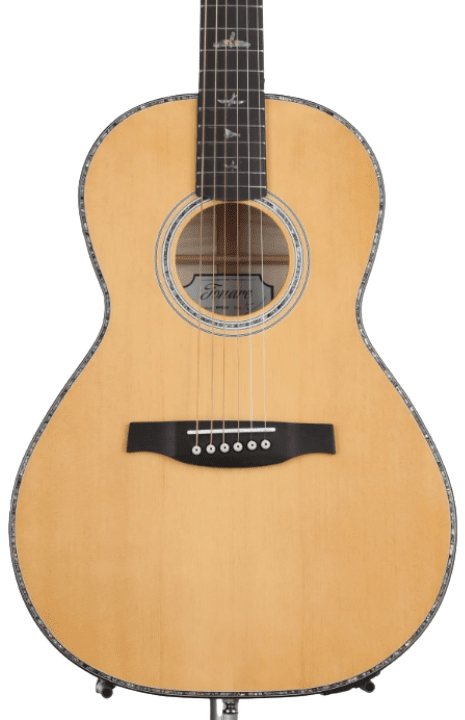
Check Today’s Price on
Summary
Pros:
- Incredibly comfortable neck for such a small guitar
- Bright projection allows for surprising volume
- Fishman electronics allow it to be played on stage
- Bone nut and saddle allow you to “feel” the tone
Cons:
- Can sound a bit harsh on the high end when played hard with a pick
- The neck is a bit wider than usually
Who is this guitar for?
- Anyone looking for a parlor guitar to record with
- Great for songwriters
- If you are looking for a smooth playability
Best for Beginners – PRS SE P20E Parlor

Check Today’s Price on
Summary
Pros:
- Very accommodating neck and fingerboard that is ideal for new players
- Classy aesthetic with attractive finishes including herringbone rosette and accents
- Reliable electronics in pickup system
- Sounds solid
Cons:
- Somewhat flat and rigid tonal response
- The guitar lacks the dynamic needed for more expressive strumming or fingerpicking
Who is this guitar for?
- Beginner players that would like to train their fingerstyle
- Anyone that wants to invest in a short term parlor guitar
- Players that want a decent guitar for more informal jams
Compare The Key Specs:

Compare The Tonewoods:
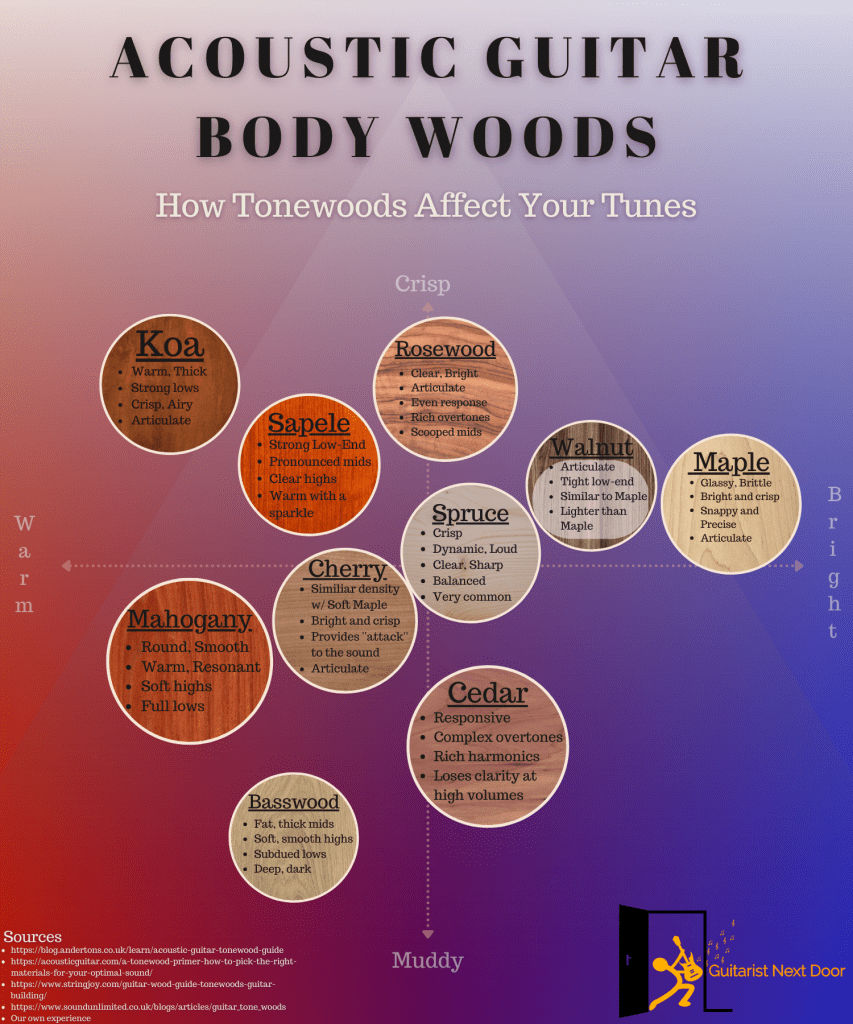
Body Top: Solid Canadian Cedar
Sides: Solid Mahogany
Back: Solid Mahogany
Neck: Mahogany
Fretboard: Rosewood
Body Top: Solid Spruce
Sides: Laminated Maple
Back: Laminated Maple
Neck: Mahogany
Fretboard: Rosewood
Body Top: Solid Mahogany
Sides: Solid Mahogany
Back: Solid Mahogany
Neck: Mahogany
Fretboard: Ovangkol
Body Top: Solid Sitka Spruce
Sides: Laminated Maple
Back: Laminated Maple
Neck: Mahogany
Fretboard: Ebony
Body Top: Solid Mahogany
Sides: Laminated Mahogany
Back: Laminated Mahogany
Neck: Mahogany
Fretboard: Ebony
You can learn more about acoustic guitar tonewoods here.
About Parlor Guitars
Are you considering getting your hands on a parlor guitar, but are unsure about the best options currently available? A great parlor guitar offers players a smaller scale design compared to regular guitars without compromising on tone or playability.
Parlor guitars can provide players with a handful of performance and user benefits, especially in more intimate performance settings such as small bars or informal jam sessions.
There’s a long list of well crafted parlor guitars on the current market, and choosing the right one can often be an overwhelming experience. We’ve put together a short hotlist of the top parlor guitars. These selections each suit a variety of performance and budget requirements.
Our Reviews of The Top 5
Not all parlor guitars are created equal, and there are a few factors to consider when shopping around for the best parlor guitar for you. Below are three considerations to keep in mind when choosing a parlor guitar:
The most defining trait of a parlor guitar is its smaller scale design. Parlor sized acoustic guitars can come in a variety of body and neck scales and profiles, so it can be helpful to test and compare a few models to find the most comfortable size for you.
Parlor guitars traditionally come with a smaller body than regular guitars and as such, have a noticeably brighter and more present tonal quality. The larger the size of a parlor guitar’s body, the more low-end it is able to generate, especially with acoustic models.
Parlor guitars generally feature low-action setups to accommodate for smaller hands. These types of setups can also be very beneficial to beginner players that still need to build their stamina and coordination while learning to play.
Best Overall – Cordoba C9 Parlor 7/8 Size Nylon String
Specs
| Body Style | Parlor |
| Top | Solid Canadian Cedar |
| Back & Sides | Solid Mahogany |
| Neck | Mahogany |
| Neck Shape | Traditional |
| Fretboard | 18 frets, Rosewood fingerboard |
| Nut | Bone |
| Nut Width | 1.96″ |
| Electronics | No |
| Saddle | Bone |
| Scale-Length | 24.8″ |
| Case Included | Polyfoam Softshell Case |
If you’re a purist looking for a proper traditionally crafted parlor guitar, the Cordoba C9 should be high on your shopping list. This ⅞ size guitar comes with a slightly smaller neck, bridge, headstock, and saddle compared to regular classical guitar builds. This design is well complemented with a handmade body consisting of a Canadian cedar top and Mahogany back and sides.
Cedar is a very popular choice for classical guitar builds, and the top is fixed using a Spanish-style lattice bracing. Lattice bracing (or fan bracing) adds tensile integrity to a guitar body, and allows it to deliver a more dynamic response than other modern bracing styles.
The combination of the C9’s cedar top and mahogany back and sides give the guitar a remarkably balanced tone, with a reliable amount of low-end response to fill up small acoustic venues without amplification.
One handy benefit from the C9’s smaller-scale design is the slightly smaller neck, which can be particularly useful for players with smaller hands or less hand strength and stamina.
The only downside of the C9 is that it does not have any electronics or pickup system, which can make it tricky to use in larger performance spaces. However for anyone looking for the best parlor acoustic guitar for its traditional purpose, the C9 is a top-shelf choice.
Another solid sound demo:
Pros:
- Very accommodating Rosewood neck and fretboard make the C9 a very inviting play for players of any skill level.
- Extremely well-blanched frequency response
- Reliable resonance and sustain for intimate acoustic performances
- Lattice bracing adds considerable dynamic for both fingerstyle and strumming performances.
Cons:
- No electronics or pickup system
- No cutaway can make it tricky to reach the highest notes on the fretboard.
What others are saying:
I’m a steel string player but wanted to expand my hobby a bit. I was deciding between the C9 and the C9 Dolce and I’m thrilled with the decision on the Dolce. It has a loud rich sound, much more than I thought it would. Perfect scale length for me especially since my steel strings are mostly 25″ Scale. It’s comfortable to play and light as a feather. – Paul from NY
Who is this guitar for?
- Fans of classical guitar build that use traditional design concepts
- Anyone looking for a reliable nylon string guitar
- Players that have smaller hands or need a guitar to train their strength and stamina.
Who is this guitar NOT for?
- Anyone that needs a guitar with built-in electronics.
- Players that require standard-size necks to perform comfortably.
Check Price on:
Best Budget – Gretsch G5021E Rancher Penguin Parlor
Specs
| Body Shape | Parlor |
| Top | Solid Spruce |
| Back & Sides | Laminated Maple |
| Neck | Mahogany |
| Neck Shape | Standard U |
| Fretboard | 20 Vintage-style frets, Rosewood fingerboard, 12″ radius. |
| Nut | Synthetic Bone |
| Nut Width | 1.673″ |
| Electronics | Fishman Presys II pickup/preamp System with Tuner |
| Saddle | Synthetic Bone |
| Scale-Length | 25″ |
Not everyone can afford to buy their dream parlor guitar right away, so it’s encouraging to know that there are some reasonably priced models on the current market that still sound pretty good. The Gretsch G5021E Rancher comes with a classy 50s Americana aesthetic that matches its bright and crispy tone.
The G5021E uses the same design fundamentals as the original rancher guitars from this era, complete with a novel triangular shaped soundhole that helps to accentuate its signature warm twang.
The G5021 is also a shining example of how reliable laminate woods can be in guitar builds. The back and sides are made using laminated maple. The woods are durable and well resistant to humidity changes.
Laminated maple has a tendency to be quite stiff if used improperly, but the guitar uses an X bracing to give the body and spruce top a surprising amount of dynamic response and flexibility. This bracing in combination with the sound hole gives the Gretsch a very mid-heavy tonal quality, with added emphasis on the high end if you’re strumming with a guitar pick.
For all its tonal and aesthetic character, the G5012E does lack a notable amount of sustain. The laminated top also dampens some of the low-end coming out of the soundhole, which doesn’t make it the best option for intimate acoustic performances.
However there is a pretty effective Fishman Presys pickup that comes built-in, and plugging the guitar into a PA system with a reliable mixer should help to compensate for the evident lack of beef in the guitar’s tone.
The G5021E might not be the best parlor guitar for touring professionals, but it certainly is one of the best budget parlor guitars currently on offer.
Find more acoustic guitars with offset soundholes here.
How this guitar sounds:
Pros:
- Bright, crispy tone that is perfect for faster fingerpicking and strumming techniques
- Very classy vintage aesthetic that compliments its tonal character
- Extremely attractive value for money
- Solid electronics
Cons:
- Notable lack of sustain
- Tonal response could use more low-end
- Does not have the most playable neck in its price bracket
What others are saying:
I’ve wanted a Gretsch Rancher for some time (I especially like the pick shaped sound hole). I have several dreadnaught sized guitars so when I saw this it was the perfect option. The guitar looks great, plays well and has a well balanced sound. The electronics are decent for this price category. It’s not as full or loud as a larger guitar but I like it for casual playing & recording at home. I chose the black model but the other color options are nice. – Stephen review from NY
Who is this guitar for?
- Fans or players of country, bluegrass, and folk-style genres
- Anyone that needs a simple travel guitar for informal jams
- Budget-minded players
- If you are in search of the best parlor guitar for the money
Who is this guitar NOT for?
- Anyone that needs a parlor guitar primarily for acoustic performances
- Players of slower-paced, more sparsely composed music
- Full-time touring professionals looking for a touring guitar
Check Price on:
Best for Strumming – Fender PS-220E Parlor
Specs
| Body Shape | Parlor |
| Top | Solid Mahogany |
| Back & Sides | Solid Mahogany |
| Neck | Mahogany |
| Neck Shape | C |
| Fretboard | Ovangkol fingerboard with 20 frets. 15.75″ radius. |
| Nut | Bone |
| Nut Width | 1.692″ (43mm) |
| Electronics | Fender/Fishman Sonitone Plus Soundhole Pickup |
| Saddle | Bone |
| Scale-Length | 25.3″ |
| Case Included | Hardshell Case |
Parlor guitars aren’t traditionally designed for abrasive strumming styles of music, but there are certain models that have accidentally fallen into this department by the luck of their design. Trust a powerful brand like Fender to produce the perfect parlor guitar for strumming (even though it’s unsure as to if this was their original intention).
The secret to the PS 220 E’s incredible sustain and resonance lies in its choice of tone woods. The PS 220E is built using all the standard scale parlor guitar parts, including a reduced body made entirely of Mahogany. Mahogany is known for its exceptional ability to capture and boost the low-end response of a guitar.
The overall resonance on the PS 220E is quite uncanny given its scaled-down body. Not only does this extensive resonance make the guitar ideal for fingerpicking, but it’s also extremely useful for strummed out chords of any speed and velocity.
Aside from all the sonic benefits that Mahogany carries, it also gives the guitar an incredibly smooth feel and look.
The PS 220E’s fretboard is constructed using Ovangkol, which is so rare that it’s even protected in certain countries. This wood has a unique spongy nature but is also quite good at resisting moisture retention. The fretboard definitely feels more accommodating than other builds in this price tier, and this can be very useful if you need a guitar for long hours of intensive playing.
Notably, the bridge on the PS 220E is also made using Ovangkol, and along with the Mahogany body creates a somewhat elastic quality to the entire build without compromising on tuning on tone. This kind of tensile integrity is prime for players that need to dig into their guitar while strumming, or that enjoy a responsive guitar with natural volume dynamics. Well worth the asking price, the PS 220E is one of the best parlors under $1000.
How this guitar sounds:
Pros:
- Expressive and resonant guitar build that allows for dynamic playing
- Mahogany body generates a useful amount of low-end
- Very accommodating fretboard that diminishes strain while playing
- Versatile tonal character
Cons:
- Tonal response can be a bit flat in the upper-mid region
- Ovangkol is known to pick up residue faster than certain other wood builds
What others are saying:
Solid mahogany guitars tend to have a “darker” sound – this is not too pronounced with this one.
If you want to use this guitar not only for blues but in a broader spectrum, you are well served.
In addition, it looks great, the top, the back and the sides are as good as natural, so there is hardly any varnish or even high-gloss varnish. I guess that’s why it vibrates so well. – Jam from Germany
Find more great Fender Acoustic guitars here.
Who is this guitar for?
- Players that need a parlor guitar for extensive hours of practice or performing
- Anyone looking for a parlor guitar to use for strumming styles of music/performance
- Fans of darker acoustic guitar tones
Who is this guitar NOT for?
- Anyone looking for a bright guitar with prominent high-end response
- Players that need a fretboard for faster chord or leadwork
Check Price on:
Best for Recording – PRS SE P50 Parlor

Specs
| Body Shape | Parlor |
| Top | Solid Sitka Spruce |
| Back & Sides | Laminated Maple |
| Neck | Mahogany |
| Neck Shape | Wide Fat |
| Fretboard | 20 frets, Ebony fingerboard, 11.8″ radius |
| Nut | Bone |
| Nut Width | 1.6875″ |
| Electronics | PRS Voiced Fishman Sonitone |
| Saddle | Bone |
| Scale-Length | 24.72″ |
Players have come to expect high-quality tonewoods from PRS, which are used in the construction of the PRS SE P50 Parlor.
This small guitar has a solid maple body and a top made of Sitka spruce. It has a lot of snappy volume for such a small guitar. It has bright, bold highs, sparkling midrange, and honestly surprising punch. Other parlor guitars we’ve played don’t seem to have a lot of tonal complexity. This does not.
The way this guitar plays is one of the more surprising aspects of it. PRS created a masterpiece that debunked the misconception that parlor guitars were only for casual strumming. You’ll have something to hold onto with the “Pattern Wide Fat” neck profile without feeling too thin or chunky. This is a huge benefit for a guitar with a body size that frequently has short, uncomfortable necks.
Like a full-sized acoustic, you can play this bad boy up and down while still feeling at ease. When strumming chords, you don’t feel like you have to cram your fingers in behind the frets.
Even playing scales is easy without having to think about how big the guitar is.
PRS added Fishman Sonitone electronics to this guitar to make it more adaptable, allowing you to connect it to your preferred acoustic guitar amplifier. Instead of making this small guitar a “travel guitar,” it can now be played on stage.
Also, let’s not forget the appearance. The stunning flamed pattern on the back and sides is only enhanced by the bird inlays and abalone body binding. PRS did more than just glue a bunch of wood together; A masterpiece was put together by them. Simply examine it!
The PRS SE P50 Parlor should be at the top of your list if you want a small guitar with a big voice.
How this guitar sounds:
Pros:
- Incredibly comfortable neck for such a small guitar
- Bright projection allows for surprising volume
- Fishman electronics allow it to be played on stage
- Bone nut and saddle allow you to “feel” the tone
Cons:
- Can sound a bit harsh on the high end when played hard with a pick
- The neck is a bit wider than usually
What others are saying:
“I’ve become a bit obsessed with trying to find my favorite guitars. 12+ acoustics in the house. This is one of my favorites…” – Sweetwater customer
Who is this guitar for?
- Anyone looking for a parlor guitar to record with
- Great for songwriters
- If you are looking for a smooth playability
Who is this guitar NOT for?
- If you are ins search for cheap parlor guitar
- If you want a parlor guitar with really slim neck
Check Price on:
Best for Beginners – PRS SE P20E Parlor
Specs
| Body Shape | Parlor |
| Top | Solid Mahogany |
| Back & Sides | Laminated Mahogany |
| Neck | Mahogany |
| Neck Shape | Wide Fat |
| Fretboard | 20 frets, Ebony fingerboard, 11.8″ radius |
| Nut | Bone |
| Nut Width | 1.6875″ |
| Electronics | Fishman Sonitone |
| Saddle | Bone |
| Scale-Length | 24.72″ |
PRS is not a name that is commonly associated with beginner guitar players. The brand has mostly found players with more experienced players and fans of technical and progressive styles of music.
With that being said, the PRS SE P20E is one of the more accommodating parlor guitars currently on offer, and is ideal for any beginner that is looking to intensively better their fingerstyle technique. Mindful players of various skill levels should notice how easy it is to play the SE P20E.
An Ebony fretboard and bridge are used for this particular build, and this combination gives the guitar an extremely smooth feel, and is noticeably forgiving on younger or less experienced hands.
There isn’t a wide range of praises that can be sung about the PRS SE P20E’s tonal character. The body, back and sides are all constructed using various forms of Mahogany, and is held together by a traditional scalloped X-bracing to give the guitar a warm, yet somewhat rigid sonic quality.
It should be stated that the P20E parlor guitar is not the most responsive build on the current market, and should instead be revered for what it does best, train learning hands. The guitar also includes a reliable Fishman Sontine Pickup, so it is open to having its mix enhanced by outside preamps and devices.
All things considered, PRS SE P20E is my pick for the best parlor guitar under $500.
Find our picks for the best acoustic guitars under $500 here.
How this guitar sounds:
Pros:
- Very accommodating neck and fingerboard that is ideal for new players
- Classy aesthetic with attractive finishes including herringbone rosette and accents
- Reliable electronics in pickup system
- Sounds solid
Cons:
- Somewhat flat and rigid tonal response
- The guitar lacks the dynamic needed for more expressive strumming or fingerpicking
What others are saying:
For the money, I don’t think you’ll find another parlor sized guitar built with the quality of this PRS. It’s a beautiful guitar with flawless construction. And the tone and volume are amazing. The only issue I had was that the action was a little high for my liking. I sanded the bridge saddle down appx. 1/16 inch and tightened the truss rod 1/4 turn. And now it plays effortlessly. I’ve been having so much fun playing it unplugged that I haven’t tried the electronics yet. But I’m sure it will sound equally amazing. I’ve owned three GS Minis and even though they are quality built small guitars, I don’t think they are worth the extra cost. And to me, the PRS parlor sounds much better. I’m proud to be a P20E owner. – Joel from Oregon
Who is this guitar for?
- Beginner players that would like to train their fingerstyle
- Anyone that wants to invest in a short term parlor guitar
- Players that want a decent guitar for more informal jams
Who is this guitar NOT for?
- Studio recording musicians and experienced touring professionals
- Anyone that needs a guitar with high amounts of dynamic and response.
Check Price on:
Runner-Ups That Just Missed The Top 5
- Best Nylon String Parlor Guitar Under $500 – Yamaha CSF1M – Check Our Favorite Yamaha Acoustic Guitars Here
- Best Cheap Parlor Guitar – Gretsch G9500 Jim Dandy Flat Top
- Runner-Up Best Parlor Guitar For Beginners – Alvarez AP66SHB Artist 66 Parlor
- Best Parlor Bass Guitar – Ibanez PNB14E
- Best Traditional Steel String Parlor – Alvarez MPA66SHB Masterworks A66 Parlor
Buyer’s Guide – FAQ
What is A Parlor Guitar?

A parlor guitar incorporates most of the same fundamental designs and features as regular guitars, but with a smaller scale body. These guitars were originally introduced in the late 1800’s for use during intimate dinner parties or other social gatherings Since their initial inception, parlor guitars have undergone various advancements and innovations to cater to different player requirements and circumstances.
What You Should Know Before Buying?
Right off the bat, it’s important for players to know that parlor guitars produce a considerably brighter and more present tone than regular guitars, thanks mostly to their smaller scale body designs.
Most parlor guitars won’t be able to match the resonance and low-end quality that regular size guitars can provide, and if these are two crucial factors for your tonal quality, then you may need to seek other options.
If you need a parlor guitar for larger performance spaces or recording, it can be handy to buy a model that has some form of pickup to allow it to be plugged into amplifiers or PA systems for appropriate mixing. Different tonewoods also create different tonal responses, which we’ll discuss in the very next section.
How to Choose The Right Parlor Guitar for You?
Best Tonewoods
Tonewoods play a vital role in the tonal quality and characteristics of any parlor guitar. Different woods respond to acoustic reflections differently, and understanding the different tonewoods used in guitar builds can be extremely useful when shopping for a parlor guitar.
Due to their smaller build, many parlor guitars are made using tops made of Spruce or Cedar to help preserve their tonal presence. Both these woods are also quite responsive, which adds dynamic and expression to fingerpicking or strumming styles.


Certain Parlor guitars utilize Rosewood on either the body or neck if the guitar needs its brightness or clarity enhanced. Mahogany is also widely used for the body of a parlor guitar as it generally adds warmth and sustain to a guitar’s tonal response.

Solid vs. Laminate Top
Both solid and laminate woods come with a set of pros and cons, and these factors should also help determine the right parlor guitar for your requirements. Laminate woods are layers of plywood stuck together to use in a guitar’s build.
Laminate woods are used to reduce the manufacturing costs of a parlor guitar and also increase its durability. However laminate wood builds also have considerably less resonance and response than traditional wood designs, and as a result can often sound rigid, overly bright and at worst- cheap.
Conversely, solid woods naturally have more resonance and sustain as they are generally more tensile. The primary downside of solid woods is that they are more costly, and can chip or scratch more easily than synthetic laminates.
Electronics
The choice and quality of electronics used in your parlor guitar’s pickup system will play a key role in determining its usefulness in recording or live performance setups. Anyone that is looking to buy an electro-acoustic parlor guitar needs to be sure they pick an option with a reliable pickup system.
Some pickup systems use a microphone placed near the soundhole of the guitar, while others use small pickups that work much like those on an electric guitar. Both of these pickup systems carry a handful of pros and cons, and ultimately there is no true better choice between the two.
Most parlor guitars with pickup systems use either piezo pickup systems, or systems with built-in microphones ( and at times, a combination of both. It should be noted that pickup systems with microphones are generally harder to service than the more common piezo pickup systems.
Popular electronic brands like Fishman, Seymour Duncan, and Dimarzio all manufacture highly reliable pickup systems. Fishman Sonitone and Presys II are the most common among parlor guitars.
What Is The Best Action for A Parlor Guitar?

The set action on a parlor guitar will largely affect the overall playability and tonal response that it provides. If the action is too high it can make the fretboard harder to navigate, while action set too low can cause fret buzz and even dead spots along the fretboard.
Most guitar technicians recommend an action of no lower than 2.78mm on the bass end of the fretboard and 1.9 mm on the treble side. Because parlor guitars mostly feature the same size neck and neck profile as regular acoustic guitars, the same rule of thumb can be applied to their recommended action.
Do Parlor Guitars Sound Different?
Parlor guitars can vary in tone depending on a variety of factors. These factors can include the choice of tonewoods, as well as the shape and cut of the body and electronics used in the pickup system. All these contributing factors play a role in a parlor guitar’s frequency response, resonance, and overall tonal characteristics.
The largest contributing factor to any parlor guitar’s tone and performance is its reduced scale body. Because parlor guitars have a smaller and slimmer body than regular acoustic guitars, they generate a distinct frequency response. Parlor-sized acoustic guitars are generally more prominent in the mid-high region of their tonal response, and are decidedly brighter than normal acoustic guitars.
Is A Parlor Guitar Good for Beginners?
Parlor guitars can be useful to beginners that need some ergonomic assistance while improving their skills. The smaller body size of a parlor guitar can make it easier for certain players to train their fingerpicking and strumming techniques, especially players with smaller or weak hands.
Certain parlor guitars also feature a slightly reduced neck profile which can make it easy to navigate the fretboard while learning to play.

Are Parlor Guitars 3/4 Sized?
While they may seem practically identical, parlor guitars and ¾ guitars are not the same thing. Parlor guitars are traditionally built using the same parts as regular guitars, but with a smaller scale body. ¾ Guitars use smaller scale parts for almost every element of their design, including the neck, headstock, bracings and basic hardware.
Are Parlor Guitars The Same as Travel Guitars?
Much like ¾ guitars, travel guitars can often be confused with parlor guitars. However the two are distinctly different in size and design. Parlor guitars come with smaller body designs than traditional builds, whereas travel guitars use smaller scale parts for the neck, body, and other parts.
Travel guitars generally have a much slimmer neck profile than parlor guitars to help cut down their size during travel. It should also be noted that due to their design, travel guitars are less durable in harsh weather conditions than parlor guitars.
A travel guitar’s reduced scale design and slimmer profiles give it slightly less structural and tensile integrity than larger guitars, which can make it more prone to being affected by changes in temperature and humidity. These changes can alter the tonal response, resonance, and tuning of your guitar especially with consistent changes.
Conclusion
Each of the above-listed picks in our list of the best parlor guitars should be able to match most players fundamental needs for playing, performing and traveling.
Understanding your personal requirements in these areas is a crucial step to picking the right parlor guitar, and will help you narrow down your options considerably. However if you’re still unsure of these needs, you can easily use the list above as a basic guide to help steer your choices.
Parlor guitars can be used by players of any skill level, from seasoned performers to hobbyist amateurs. Whenever possible, try to get your hands on the guitar that you are thinking of buying for proper testing. This practice is always the absolute best way to know which is the best parlor acoustic guitar for you.


